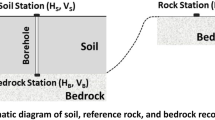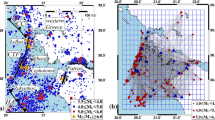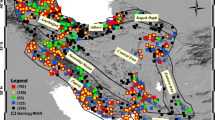Abstract
In seismic hazard studies, the Horizontal-to-Vertical Spectral Ratio (HVSR) is nowadays routinely considered as a quick way to assess possible amplification effects. However, because of several issues that can affect the data, the HVSR cannot be considered as valid per se, and a careful data evaluation is necessary. In this study, a series of HVSR curves are evaluated in order to highlight industrial components that can significantly alter the natural HVSR. First, a controlled-source experiment is carried out in order to define the characteristics of spurious industrial signals. Data analysis shows that the coherence functions and the mildly smoothed amplitude spectra plotted with linear scales can help significantly in identifying industrial components that can be otherwise difficult to highlight. Coherence functions appear particularly interesting because of their ability to reveal the presence of industrial components independently of their amplitude. Field data from three sites are then analyzed on the basis of the evidence obtained through the controlled-source experiment. For the third site, data recorded on two different days are considered. While in the first data set no significant industrial component is present, in the second and third data sets, a series of remarkable industrial signals that severely alter the natural HVSR are identified. The assessment of the coherence functions and mildly smoothed amplitude spectra is therefore suggested as a valuable support to avoid pitfalls in the interpretation of the experimental HVSR. Finally, two quick and dirty procedures aimed at reducing the effect of industrial components are also presented.




















Similar content being viewed by others
References
Ali, M. Y., Berteussen, K. A., Small, J., & Barkat, B. (2010). A low-frequency passive seismic array experiment over an onshore oil field in Abu Dhabi, United Arab Emirates. Geophysics, 78, B159–B176.
Arai, H., & Tokimatsu, K. (2004). S-wave velocity profiling by inversion of microtremor H/V spectrum. Bulletin of the Seismological Society of America, 94, 53–63.
Arai, H., & Tokimatsu, K. (2005). S-Wave velocity profiling by joint inversion of microtremor dispersion curve and horizontal-to-vertical (H/V) spectrum. Bulletin of the Seismological Society of America, 95, 1766–1778.
Asten, M. W. (1978). Geological control on the three-component spectra of Rayleigh-wave microseisms. Bulletin of the Seismological Society of America, 68, 1623–1636.
Asten, M. W., & Henstridge, J. D. (1984). Array estimators and the use of microseisms for reconnaissance of sedimentary basins. Geophysics, 49, 1828–1837.
Beauduin, R., Lognonné, P., Montagner, J. P., Cacho, S., Karczewski, J. F., & Morand, M. (1996). The effects of the atmospheric pressure changes on seismic signals or How to improve the quality of a station. Bulletin of the Seismological Society of America, 86(6), 1760–1769.
Berger, J., Davis, P., & Ekström, G. (2004). Ambient Earth noise: A survey of the global seismographic network. Journal Geophysical Research, 109, B11307.
Berteussen, K., Ali, M. Y., Small, J., & Barkat, B. (2008). A low frequency, passive seismic experiment over a carbonate reservoir in Abu Dhabi—Wavefront and particle motion study. In 70th EAGE Conference & Exhibition, Rome. Extended Abstract, B046.
Bonnefoy-Claudet, S., Cornou, C., Bard, P., Cotton, F., Moczo, P., Kristek, J., et al. (2006a). H/V ratio: A tool for site effects evaluation. Results from 1-D noise simulations. Geophysical Journal International, 167, 827–837.
Bonnefoy-Claudet, S., Cotton, F., & Bard, P.-Y. (2006b). The nature of noise wavefield and its applications for site effects studies: A literature review. Earth-Science Reviews, 79, 205–227.
Bonnefoy-Claudet, S., Kohler, A., Cornou, C., Wathelet, M., & Bard, P.-Y. (2008). Effects of love waves on microtremor H/V ratio. Bulletin of the Seismological Society of America, 98, 288–300.
Bormann, P. (Ed.). (2012). New manual of seismological observatory practice (NMSOP-2). Potsdam: Deutsches GeoForschungszentrum GFZ; IASPEI. https://doi.org/10.2312/GFZ.NMSOP-2.
Braddner, H., & Dodds, I. G. (1964). Comparative seismic noise on the ocean bottom and on land. Journal Geophysical Research, 69(20), 4339–4348.
Brune, J. N., & Oliver, J. (1959). The seismic noise of the Earth´s surface. Bulletin of the Seismological Society of America, 49, 349–353.
Cessaro, R. K. (1994). Sources of primary and secondary microseisms. Bulletin of the Seismological Society of America, 84, 142–148.
Chávez-García, F. J., & Kang, T. S. (2014). Lateral heterogeneities and microtremors: Limitations of HVSR and SPAC based studies for site response. Engineering Geology, 174, 1–10.
Dal Moro, G. (2010). Insights on surface-wave dispersion curves and HVSR: Joint analysis via pareto optimality. Journal of Applied Geophysics, 72, 29–140.
Dal Moro, G. (2011). Some aspects about surface wave and HVSR analyses: A short overview and a case study. Bollettino di Geofisica Teorica e Applicata, 52, 241–259.
Dal Moro, G. (2014). Surface wave analysis for near surface applications. Amsterdam: Elsevier. ISBN 9780128007709.
Dal Moro, G. (2015). Joint inversion of Rayleigh-wave dispersion and HVSR of lunar seismic data from the Apollo 14 and 16 sites. Icarus, 254, 338–349.
Dal Moro, G. (2019). Effective active and passive seismics for the characterization of urban and remote areas: Four channels for seven objective functions. Pure and Applied Geophysics, 176, 1445–1465. https://doi.org/10.1007/s00024-018-2043-2.
Di Giulio, G., Improta, L., Calderoni, G., & Rovelli, A. (2008). A study of the seismic response of the city of Benevento (Southern Italy) through a combined analysis of seismological and geological data. Engineering Geology, 97, 146–170.
Dimitriu, P., Kalogeras, I., & Theodulidis, N. (1999). Evidence of nonlinear site response in horizontal-to-vertical spectral ratio from near-field earthquakes. Soil Dynamics and Earthquake Engineering, 18, 423–435.
Eker, A. M., Koçkar, M. K., & Akgün, H. (2015). Evaluation of site effect within the tectonic basin in the northern side of Ankara. Engineering Geology, 192, 76–91.
Fäh, D., Kind, F., & Giardini, D. (2001). A theoretical investigation of average H/V ratios. Geophysical Journal International, 145, 535–549.
Fasan, M., Magrin, A., Amadio, C., Romanelli, F., Vaccari, F., & Panza, G. F. (2016). A seismological and engineering perspective on the 2016 Central Italy earthquakes. International Journal of Earthquake and Impact Engineering, 1, 395–420.
Field, E. H., Hough, S. E., & Jacob, K. H. (1990). Using microtremors to assess potential earthquake site response: A case study in flushing meadows, New York City. Bulletin of the Seismological Society of America, 80, 1456–1480.
Fix, J. E. (1972). Ambient Earth motion in the period range from 0.1 to 2560 sec. Bulletin of the Seismological Society of America, 62, 1753–1760.
Friedrich, A., Klinge, K., & Krüger, F. (1998). Ocean-generated microseismic noise located with the Gräfenberg array. Journal of Seismology, 2, 47–64.
Fyen, J. (1990). Diurnal and seasonal variations in the microseismic noise observed at the NORESS array. Physics of the Earth and Planetary Interiors, 63, 252–268.
Goldstein, P., & Archuleta, R. J. (1987). Array analysis of seismic signals. Geophysical Research Letters, 14, 13–16.
Gómez González, A., Rodríguez, J., Sagartzazu, X., Schumacher, A., & Isasa. I. (2010). Multiple coherence method in time domain for the analysis of the transmission paths of noise and vibrations with non-stationary signals. In Proceedings of the 2010 international conference of noise and vibration engineering, ISMA2010-USD2010 (pp. 3927–3941).
Groos, J. C., & Ritter, J. R. R. (2009). Time domain classification and quantification of seismic noise in an urban environment. Geophysical Journal International, 179, 1213–1231.
Gupta, P., & Kar, S. P. (2015). MUSIC and improved MUSIC algorithm to estimate direction of arrival. In Proceedings 2015 International conference of the communications and signal processing (ICCSP). https://doi.org/10.1109/iccsp.2015.7322593.
Gutenberg, B. (1958). Microseismic. Advances in Geophysics, 5, 53–92.
Haghshenas, E., Bard, P. Y., Theodulidis, N., et al. (2008). Empirical evaluation of microtremor H/V spectral ratio. Bulletin of Earthquake Engineering, 6, 75–108.
Hasselmann, K. A. (1963). A statistical analysis of the generation of microseisms. Reviews of Geophysics, 1, 177–209.
Haubrich, R. A., & McCamy, K. (1969). Microseisms coastal and pelagic sources. Reviews of Geophysics and Space Physics, 7, 539–571.
Holcomb, L. G. (1998). Spectral structure in the Earth’s microseismic background between 20 and 40 seconds. Bulletin of the Seismological Society of America, 88, 744–757.
Kedar, S., & Webb, F. (2005). The ocean’s seismic hum. Science, 307, 682–683.
Konno, K., & Ohmachi, T. (1998). Ground-motion characteristics estimated from spectral ratio between horizontal and vertical components of microtremor. Bulletin of the Seismological Society of America, 88, 228–241.
Longuet-Higgins, M. (1950). A theory of the origin of microseisms. Philosophical Transactions of the Royal Society of London. Series A, Mathematical and Physical Sciences, 243, 1–35.
Mark, N., & Sutton, G. H. (1975). Lunar shear velocity structure at Apollo sites 12, 14, and 15. Journal Geophysical Research, 80, 4932–4938.
Marzorati, Z., & Bindi, D. (2006). Ambient noise levels in north central Italy. Geochemistry, Geophysics, Geosystems. https://doi.org/10.1029/2006GC001256.
Matsushima, S., Kosaka, H., & Kawase, H. (2017). Directionally dependent horizontal-to-vertical spectral ratios of microtremors at Onahama, Fukushima, Japan. Earth Planets Space, 69, 96.
Mohamed, A., Lindholm, C., & Cirgis, M. (2015). Site characterization and site response study of the Sahary area, South Egypt. Acta Geodynamica et Geomaterialia, 12, 427–436.
Murphy, A. J., & Savino, J. R. (1975). A comprehensive study of long period (20–200 s) Earth noise at the high gain worldwide seismograph stations. Bulletin of the Seismological Society of America, 65, 1827–1862.
Nakamura, Y. (1989). A method for dynamic characteristics estimation of subsurface using microtremor on the ground surface. Quarterly Report of Railway Technical Research Institute, 30, 25–33.
Nakamura, Y. (1996). Realtime information systems for seismic hazard mitigation. Quarterly Report of Railway Technical Research Institute, 37, 112–127.
Nakamura, Y. (2000). Clear identification of fundamental idea of Nakamura’s technique and its applications. In Proceedings of the XII world conference on earthquake engineering, New Zealand. Paper no 2656.
Oliver, J., & Ewing, M. (1957). Microseisms in the 11- to 18-second period range. Bulletin of the Seismological Society of America, 47, 111–127.
Olsen, K. B. (2000). Site amplification in the Los Angeles basin from three-dimensional modeling of ground motion. Bull Seism Soc Am, 90, S77–S94.
Panzera, F., D’Amico, S., Lupi, M., Mauri, G., Karyono, K., & Mazzini, A. (2018). Lusi hydrothermal structure inferred through ambient vibration measurements. Marine and Petroleum Geology, 90, 116–124.
Panzera, F., Halldorsson, B., & Vogfjörð, K. (2017a). Directional effects of tectonic fractures on ground motion site amplification from earthquake and ambient noise data: A case study in South Iceland. Soil Dynamics and Earthquake Engineering, 97, 143–154.
Panzera, F., Lombardo, G., Sicali, S., & D’Amico, S. (2017b). Surface geology and morphologic effects on seismic site response: The study case of Lampedusa, Italy. Physics and Chemistry of the Earth, 98, 62–72.
Perron, V., Gélis, C., Froment, B., Hollender, F., Bard, P.-Y., Cultrera, G., et al. (2018). Can broad-band earthquake site responses be predicted by the ambient noise spectral ratio? Insight from observations at two sedimentary basins. Geophysical Journal International, 215, 1442–1454.
Peterson, J. (1993). Observations and modeling of seismic background noise (pp. 93–322). Open File Report: US Geological Survey.
Phillips, C., & Hashash, Y. M. A. (2009). Damping formulation for nonlinear 1D site response analyses. Soil Dynamics and Earthquake Engineering, 29, 1143–1158.
Picozzi, M., & Albarello, D. (2007). Combining genetic and linearized algorithms for a two-step joint inversion of Rayleigh wave dispersion and H/V spectral ratio curves. Geophysical Journal International, 169, 189–200.
Rodriguez, V. H. S., & Midorikawa, S. (2002). Applicability of the H/V spectral ratio of microtremors in assessing site effects on seismic motion. Earthquake Engineering and Structural Dynamics, 31, 261–279.
Rong, M., Fu, L. Y., Wang, Z., Li, X., Carpenter, N. S., Woolery, E. W., et al. (2017). On the amplitude discrepancy of HVSR and site amplification from strong-motion observations. Bulletin of the Seismological Society of America, 107, 2873–2884. https://doi.org/10.1785/0120170118.
Rost, S., & Thomas, C. (2002). Array seismology: Methods and applications. Reviews of Geophysics, 40, 1008.
Savino, J., McCamy, K., & Hade, G. (1972). Structures in Earth noise beyond twenty seconds—a window for earthquakes. Bulletin of the Seismological Society of America, 62, 141–176.
Seed, H. B., & Idriss, I. M. (1971). Influence of soil conditions on building damage potential during earthquakes. Journal of the Structural Division, ASCE, 97, 639–663.
SESAME. (2004). Guidelines for the implementation of the H/V spectral ratio technique on ambient vibrations measurements. In Processing and interpretation open file. ftp://ftp.geo.uib.no/pub/seismo/SOFTWARE/SESAME/USER-GUIDELINES/SESAME-HV-User-Guidelines.pdf. Retrieved on January 2020.
Stutzmann, E., Ardhuin, F., Schimmel, M., Mangeney, A., & Patau, G. (2012). Modelling long-term seismic noise in various environments. Geophysical Journal International, 191, 707–722.
Tanimoto, T. (1999). Excitation of normal modes by atmospheric turbulence: Source of long-period seismic noise. Geophysical Journal International, 136, 395–402.
Tanimoto, T., Ishimaru, S., & Alvizuri, C. (2006). Seasonality in particle motion of microseisms. Geophysical Journal International, 166, 253–266.
van der Baan, M. (2009). The origin of SH-wave resonance frequencies in sedimentary layers. Geophysical Journal International, 178, 1587–1596.
Webb, S. C. (1998). Broadband seismology and noise under the ocean. Reviews of Geophysics, 36, 105–142.
Webb, S. C. (2007). The Earth’s ‘hum’ is driven by ocean waves over the continental shelves. Nature, 445, 754–756.
Wilcock, W. S. D., Webb, S. C., & Bjarnason, I Th. (1999). The effect of local wind on seismic noise near 1 Hz at the MELT site and on Iceland. Bulletin of the Seismological Society of America, 89, 1543–1557.
Withers, M. M., Aster, R. C., Young, C. J., & Chael, E. P. (1996). High-frequency analysis of seismic background noise as a function of wind speed and shallow depth. Bulletin of the Seismological Society of America, 86, 1507–1515.
Yang, Y., & Ritzwoller, M. H. (2008). The characteristics of ambient seismic noise as a source for surface wave tomography. Geochemistry, Geophysics, Geosystems, 9, Q02008.
Young, Ch J, Chael, E. P., Withers, M. W., & Aster, R. C. (1996). A comparison of the high- frequency (> 1 Hz) surface and subsurface noise environment at three sites in the United States. Bulletin of the Seismological Society of America, 86, 1516–1528.
Zürn, W., & Wielandt, E. (2007). On the minimum of vertical seismic noise near 3 mHz. Geophysical Journal International, 168, 647–658.
Acknowledgements
This work was supported in part by the Institute of Rock Structure and Mechanics (Czech Academy of Sciences, Prague, CZ) in the framework of the long-term conceptual development project RVO 67985891 (Institute grant for the “Extreme Seismics” project). The author is also grateful to two anonymous reviewers for their several helpful comments and suggestions.
Author information
Authors and Affiliations
Corresponding author
Additional information
Publisher's Note
Springer Nature remains neutral with regard to jurisdictional claims in published maps and institutional affiliations.
Electronic supplementary material
Below is the link to the electronic supplementary material.
Appendix: Two Simple Ways to Attenuate Industrial Components in the HVSR Curve
Appendix: Two Simple Ways to Attenuate Industrial Components in the HVSR Curve
In this section, the site #2 data are used to briefly illustrate two possible simple (quick and dirty) ways of handling HVSR curves altered by significant industrial components.
Since in such a data set the effect of the 1.5-Hz industrial component is particularly clear and distinguishable from the natural background microtremor field (see Figs. 9, 10 and 11), it is possible to try to compute the HVSR after having manually interpolated (picked) the mean amplitude spectra of the three (UD, NS and EW) components. Figure 21 summarizes the results obtained when following this approach. The upper plot (Fig. 21a) shows the original amplitude spectra (5% smoothing, thin lines) and the manually interpolated (picked) spectra obtained by simply ignoring the large 1.5-Hz spurious peaks (thick lines). In the lower plot (Fig. 21b), the HVSR curves from the original raw data (thin line) and from the picked amplitude spectra (thick line) are presented.
Site #2: reconstruction of the HVSR through the picking of the mean amplitude spectra: a mean amplitude spectra obtained by applying a 5% smoothing (thin lines) and picked while bypassing the 1.5-Hz industrial peaks (tick lines) [red: UD; green: NS; blue: EW]; b HVSR obtained by considering the original (5% smoothed) amplitude spectra (thin line) and by computing the H/V ratio from the picked amplitude spectra shown in the upper plot (thick line)
Because of the small (5%) smoothing, the HVSR peak obtained from the raw data (thin line in Fig. 21b) is larger than that obtained when using a 15% smoothing (as usually applied for the computation of the HVSR; compare Fig. 21b with Fig. 9b).
Since the 1.5-Hz signal is so well-defined (quasi-monochromatic signal), while the rest of the spectra are quite smooth, in order to smooth the 1.5-Hz spurious peak, we might also try a different (and quite brutal) approach: increasing the spectral smoothing to a very high level. Figure 22 shows the amplitude spectra and HVSR curve when adopting 90% spectral smoothing.
For this kind of data (spectra), the two approaches provide similar (but not identical) results. In both cases, the H/V peak decreases from the original value of 12.5 (Fig. 9b) to about 4–4.5 (Figs. 21b, 22b).
Clearly, both of these approaches (and particularly the second) are quite crude and are presented just to show how large the peaks produced by industrial components can be and how to possibly handle them in case the latter are well-characterized with respect to the background natural microtremor field (it must be considered that a notch filter cannot be applied, because it would also remove the part of the signal which is related to the natural microtremor field).
Note that the two approaches are applied to the final mean curves (so in the frequency domain) and can be considered simply as quick and dirty techniques aimed at obtaining a gross estimate of the HVSR due to the natural microtremors only.
Rights and permissions
About this article
Cite this article
Dal Moro, G. On the Identification of Industrial Components in the Horizontal-to-Vertical Spectral Ratio (HVSR) from Microtremors. Pure Appl. Geophys. 177, 3831–3849 (2020). https://doi.org/10.1007/s00024-020-02424-0
Received:
Revised:
Accepted:
Published:
Issue Date:
DOI: https://doi.org/10.1007/s00024-020-02424-0






